The nurse observes a client prepare a meal in the kitchen of a rehabilitation facility prior to discharge. Which behavior(s) indicate the client understands how to maintain balance safely? (Select all that apply.)
Bends from the waist to pick trash off the floor.
Widens stance while working near the sink.
Locks knees while preparing food on the counter.
Brings a heavy can close to body before lifting.
Leans forward to pull a pan from a high shelf
Correct Answer : B,D
A) Incorrect- This behavior is not safe for maintaining balance. Bending from the waist can increase the risk of falling. Clients should bend at the knees and use proper body mechanics to pick up objects from the floor.
B) Correct- Widening the stance provides a broader base of support, which can help improve balance and stability while working near the sink. This is a safe behavior to maintain balance.
C) Incorrect- Locking the knees while standing can lead to instability and decreased balance. It is recommended to keep the knees slightly flexed to maintain better balance.
D) Correct- Bringing a heavy object close to the body before lifting minimizes strain on the back and helps maintain balance. This is a safe behavior when lifting objects.
E) Incorrect- Leaning forward to pull an object from a high shelf can disrupt the center of balance and increase the risk of falling. It's important to use a step stool or ask for assistance when reaching for items on high shelves.
Nursing Test Bank
Naxlex Comprehensive Predictor Exams
Related Questions
Correct Answer is A,B,C,D,E
Explanation
A) This is because the client is experiencing an allergic reaction to piperacillin, which can be life-threatening. The nurse should stop the infusion immediately to prevent further exposure to
the drug and assess vital signs to monitor for signs of anaphylaxis, such as hypotension, tachycardia, wheezes, or stridor.
B) Assessing vital signs is a priority to determine the severity of the reaction and the client's overall condition.
C) The nurse should contact the healthcare provider to report the situation and obtain orders for treatment, such as antihistamines, corticosteroids, or epinephrine.
D) The nurse should initiate an adverse event report to document the incident and follow the facility's protocol for reporting medication errors.
E) The nurse should also document the reaction to the drug in the client's chart and notify the pharmacy to avoid future administration of piperacillin or related antibiotics.

Correct Answer is C
Explanation
Whether you are a student looking to ace your exams or a practicing nurse seeking to enhance your expertise , our nursing education contents will empower you with the confidence and competence to make a difference in the lives of patients and become a respected leader in the healthcare field.
Visit Naxlex, invest in your future and unlock endless possibilities with our unparalleled nursing education contents today
Report Wrong Answer on the Current Question
Do you disagree with the answer? If yes, what is your expected answer? Explain.
Kindly be descriptive with the issue you are facing.
